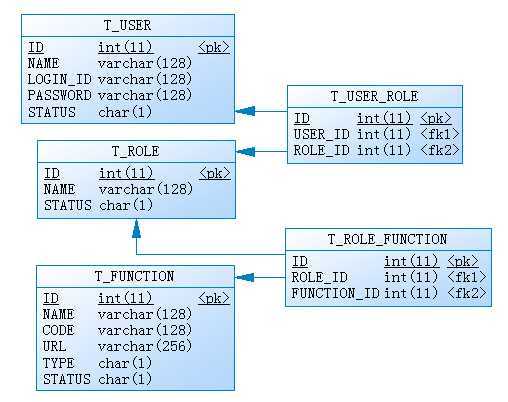标签:
权限控制存在于大多数系统当中,因为大多数系统都需要:
一个公司一般来说开发、维护多个系统,而权限控制又常见于各系统中,为避免重复劳动,可以将权限控制提取出一个系统,再通过RPC方式供其他系统调用,如HTTP、Web Service。
一般来说,系统的权限校验点在于,并不限于:
对于上述这些基础的功能,经典的权限5表就可实现:

MYSQL DDL :

drop table if exists T_FUNCTION; drop table if exists T_ROLE; drop table if exists T_ROLE_FUNCTION; drop table if exists T_USER; drop table if exists T_USER_ROLE; /*==============================================================*/ /* Table: T_FUNCTION */ /*==============================================================*/ create table T_FUNCTION ( ID int(11) not null, NAME varchar(128) comment ‘名称‘, CODE varchar(128) comment ‘功能编码‘, URL varchar(256) comment ‘功能链接(请求地址)‘, TYPE char(1) comment ‘类型:菜单、按钮‘, STATUS char(1) comment ‘状态:有效、无效‘, primary key (ID) ); /*==============================================================*/ /* Table: T_ROLE */ /*==============================================================*/ create table T_ROLE ( ID int(11) not null, NAME varchar(128) comment ‘名称‘, STATUS char(1) comment ‘状态:有效、无效‘, primary key (ID) ); /*==============================================================*/ /* Table: T_ROLE_FUNCTION */ /*==============================================================*/ create table T_ROLE_FUNCTION ( ID int(11) not null, ROLE_ID int(11), FUNCTION_ID int(11), primary key (ID) ); /*==============================================================*/ /* Table: T_USER */ /*==============================================================*/ create table T_USER ( ID int(11) not null, NAME varchar(128) comment ‘名字‘, LOGIN_ID varchar(128) comment ‘登录ID‘, PASSWORD varchar(128) comment ‘密码‘, STATUS char(1) comment ‘状态:有效、无效‘, primary key (ID) ); /*==============================================================*/ /* Table: T_USER_ROLE */ /*==============================================================*/ create table T_USER_ROLE ( ID int(11) not null, USER_ID int(11), ROLE_ID int(11), primary key (ID) ); alter table T_ROLE_FUNCTION add constraint FK_Reference_3 foreign key (ROLE_ID) references T_ROLE (ID) on delete restrict on update restrict; alter table T_ROLE_FUNCTION add constraint FK_Reference_4 foreign key (FUNCTION_ID) references T_FUNCTION (ID) on delete restrict on update restrict; alter table T_USER_ROLE add constraint FK_Reference_1 foreign key (USER_ID) references T_USER (ID) on delete restrict on update restrict; alter table T_USER_ROLE add constraint FK_Reference_2 foreign key (ROLE_ID) references T_ROLE (ID) on delete restrict on update restrict;
由于权限系统是多个系统共同使用的,所以需要加上所属系统的属性:

MYSQL DDL :

drop table if exists T_FUNCTION; drop table if exists T_ROLE; drop table if exists T_ROLE_FUNCTION; drop table if exists T_SYSTEM; drop table if exists T_USER; drop table if exists T_USER_ROLE; /*==============================================================*/ /* Table: T_FUNCTION */ /*==============================================================*/ create table T_FUNCTION ( ID int(11) not null, NAME varchar(128) comment ‘名称‘, CODE varchar(128) comment ‘功能编码‘, URL varchar(256) comment ‘功能链接(请求地址)‘, TYPE char(1) comment ‘类型:菜单、按钮‘, STATUS char(1) comment ‘状态:有效、无效‘, SYSTEM_ID int(11) comment ‘系统编码‘, primary key (ID) ); /*==============================================================*/ /* Table: T_ROLE */ /*==============================================================*/ create table T_ROLE ( ID int(11) not null, NAME varchar(128) comment ‘名称‘, STATUS char(1) comment ‘状态:有效、无效‘, SYSTEM_ID int(11) comment ‘系统编码‘, primary key (ID) ); /*==============================================================*/ /* Table: T_ROLE_FUNCTION */ /*==============================================================*/ create table T_ROLE_FUNCTION ( ID int(11) not null, ROLE_ID int(11), FUNCTION_ID int(11), primary key (ID) ); /*==============================================================*/ /* Table: T_SYSTEM */ /*==============================================================*/ create table T_SYSTEM ( ID int(11) not null, NAME varchar(128), STATUS char(1), primary key (ID) ); /*==============================================================*/ /* Table: T_USER */ /*==============================================================*/ create table T_USER ( ID int(11) not null, NAME varchar(128) comment ‘名字‘, LOGIN_ID varchar(128) comment ‘登录ID‘, PASSWORD varchar(128) comment ‘密码‘, STATUS char(1) comment ‘状态:有效、无效‘, primary key (ID) ); /*==============================================================*/ /* Table: T_USER_ROLE */ /*==============================================================*/ create table T_USER_ROLE ( ID int(11) not null, USER_ID int(11), ROLE_ID int(11), primary key (ID) ); alter table T_FUNCTION add constraint FK_Reference_6 foreign key (SYSTEM_ID) references T_SYSTEM (ID) on delete restrict on update restrict; alter table T_ROLE add constraint FK_Reference_5 foreign key (SYSTEM_ID) references T_SYSTEM (ID) on delete restrict on update restrict; alter table T_ROLE_FUNCTION add constraint FK_Reference_3 foreign key (ROLE_ID) references T_ROLE (ID) on delete restrict on update restrict; alter table T_ROLE_FUNCTION add constraint FK_Reference_4 foreign key (FUNCTION_ID) references T_FUNCTION (ID) on delete restrict on update restrict; alter table T_USER_ROLE add constraint FK_Reference_1 foreign key (USER_ID) references T_USER (ID) on delete restrict on update restrict; alter table T_USER_ROLE add constraint FK_Reference_2 foreign key (ROLE_ID) references T_ROLE (ID) on delete restrict on update restrict;
具备角色继承的设计,待续。。。
标签:
原文地址:http://www.cnblogs.com/nick-huang/p/4361016.html